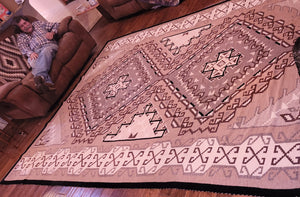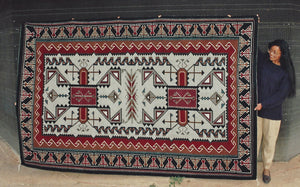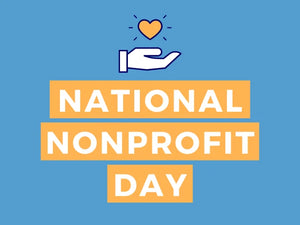What is my Grandmother's rug Worth?

Here at Nizhoni Ranch Gallery we get our fair share of inquiries about Navajo rugs people have inherited from family members. Most stories begin with something like "my grandmother bought a weaving from a trading post while vacationing in the Southwest"
The main question we are asked is "what is it worth?" The answer is: it depends... In valuing weavings we suggest keeping the following things at the forefront:
Size, Condition, Complexity of Design, Age, Tightness of weave, Types of dyes used (natural vs aniline) and provenance.
Size
Yes, size matters - a lot. Big rugs are rare which of course increases value. Past and present weavers typically weave small to medium size rugs. One reason is limited space. The larger the rug, the larger the loom. Many Navajo live in homes that have low ceilings and low square footage, which makes it nearly impossible for many weavers to take on large rugs. Another is the amount of time it takes to weave large rugs. Large rugs can take a year or more to complete. Weaver's payday typically come when they sell their rug. Which means fewer weavers then and now take on large rugs.

Condition
The condition of a Navajo Rug will of course affect the value. Pay attention to any damage, if it is clean, edges are damages, if there is any fading (one side is lighter than the other), if the wool colors have run, stains, etc. There are talented rug restores out there, yet some issues just cannot be fixed. Navajo rugs that have serious damage may not not even be worth the original cost. One rug restoration company we recommend our customers to is: Enver From Denver.
Age
1840 to 1950
Navajo rugs before the 1950's we consider historic or antique. Navajo weavings started to become popular at about the turn of the century. Navajo Textiles from 1800's have a much higher value - and they don't have to be in perfect condition. Just ask Big LT... and his amazing weaving
1940 to 1970
In mid 1900 the Southwest was all the rage. The Navajo keyed in on this and began weaving rugs for tourists. A perfect and inexpensive souvenir that could easily fit in a suitcase to take home. Navajo weavers would set up along side tourist routes. Few tourists could resist a beautiful piece of art. The weavings were small in size, designs were simple yet colorful, not always finely woven and not with the best wool. These weavings typically have a moderate value. Not necessarily a valuable family heirloom, but a warm reminder of who passed it down.

Yei Pictorial, 41" x 60", Circa 1940-1950, GHT 2304, $4,500
1970 to Present
Today's Contemporary Navajo rugs, can range from UNDER $500 up to many thousands of dollars. The number of Navajo weavers working today is dwindling. Many Navajo are not learning this sacred Navajo weaving tradition, as it is a very time consuming, the pay is inconsistent and requires discipline in learning the art form.
American Indian Double Saddle Blanket, 32" x 63", Circa 1970-1980, SG 28, $ 1,000
Complexity/Tightness
There are 28 Styles of Navajo Rugs. Some Styles are more difficult to weave than others. Complexity and tightness of the weave affect the value. Generally speaking, the tighter and finer the weave, the more valuable the piece. Teec Nos Pos is generally considered the most intricate design.

Navajo Churro Collection, Teec Nos Pos, Geraldine Phillips, 6"1" x 12'1", Churro wool, 2015 Geraldine won Best of Category for large rugs in 2015. Churro # 1574, $16,000, 520-455-5020.
Natural Dyes vs Aniline
Using natural dyes vs aniline dyes (commercial chemical dye). Natural dyes add value because of the extra time it takes to hand dye the wool. Hand dying wool with natural dyes can take almost as much time as weaving the rug. See a previous blog we wrote on natural dyes: An Organic Experience

Double Saddle Blanket, 35" x 58", Circa 1900-1910
GHT 2312, $ 1,250
Provenance
Provenance is the history of the weaver and ownership of the weaving. When the history of a weaving can be verified it takes on a whole new value. The well known story of the PBS Antique Roadshow Ute blanket's provenance went all the way back to Kit Carson. A must see video from Antique Road Show - warning it is a tear jerker!
First Phase Ute Blanket, circa 1850, PBS Antique Roadshow
The Bottom Line
If you want to get an accurate value on a weaving, contact a certified appraiser that specializes in Native American art, or better yet Navajo weavings. Nizhoni Ranch does not do appraisals, as we are not certified appraisers. We suggest contacting Joan Caballero Appraisals in Amarillo/New Mexico : website http://www.collectorsguide.com/jcaballero.
Happy Trails,
Steve, Gail, Robin and Beth
Nizhoni Ranch Gallery
Phone: 520-455- 5020
Email: steve@navajorug.com
- Beth Barth








